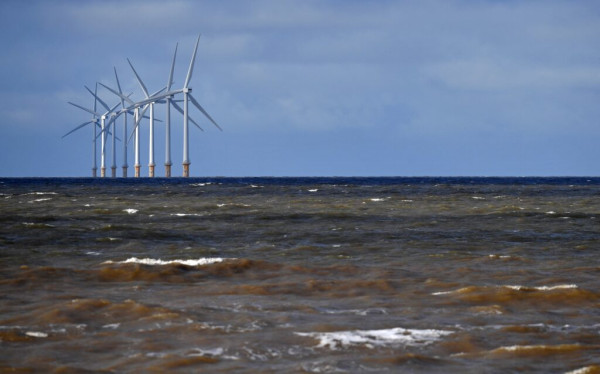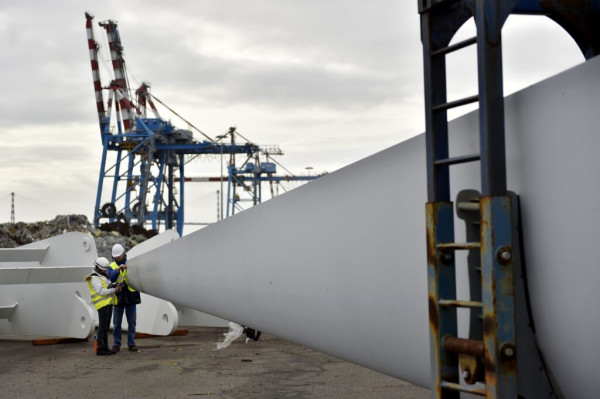Keir Starmer channels his inner Boris Johnson
LONDON — Keir Starmer and Boris Johnson were the bitterest rivals. Yet it turns out they have one thing in common: a love for windmills bobbing in the ocean.
Back in 2020, Johnson, then U.K. prime minister, conjured a patriotic vision of a green post-pandemic recovery.
“We will build windmills that float on the sea … Far out in the deepest waters, we will harvest the gusts!” Johnson enthusiastically told the Conservative Party conference. “As Saudi Arabia is to oil, so the U.K. is to wind — a place of almost limitless resource.”
It was vintage Johnson, the would-be “world king” who loved to put his stamp on the latest global mega project.
Starmer, by contrast, is dogged by criticism that he is gloomy and robotic. He has spent his early weeks in Number 10 telling British voters how bad everything is. The PM’s own aides want him to cheer up.
But when he glimpsed the same vision as Johnson, of wind turbines spinning far out at sea, the Labour leader suddenly sounded as booster-ish as his old Tory nemesis.
This new technology — floating offshore wind — “is going to be a game-changer,” Starmer proclaimed in March, on a trip to see green industry on the north Wales coast. “Some country in the world is going to be the leader, and I want that to be the U.K.,” he enthused.
Starmer calls it “a frontier technology.” Aides to Energy Secretary Ed Miliband said the government wants to be its “world leader.” Both are betting on a post-2030 export boom, if the U.K. can develop the industry ahead of rivals in the next five years, at a time when ministers desperately need help to hit net zero carbon emissions by 2050.
Labour's new publicly-owned power company, GB Energy, backed with £8 billion to invest in green schemes in the next five years, has earmarked floating wind as one of the “emerging technologies which could revolutionize the entire sector.” Earlier this month, the Crown Estate, which owns the seabed off England, Wales and Northern Ireland, invited energy companies to buy up rights to build what it says could, by the mid-2030s, be one the world’s biggest floating offshore wind zones, off the south-west coast of Britain.
The challenge for Starmer and co. is to take one of Johnson’s grand ideas and — unlike so often under his predecessor — make sure it does not fall apart on contact with reality.
Hope floats
Some industry leaders warn that Labour is dreaming far too big.
The idea the U.K. could become a global factory floor, exporting floating green tech all over the world, is “fanciful,” said energy investor Michael Liebrich, even if it could corner some specialist bits of the supply chain.

Other sector experts think it's just too soon for the soaring rhetoric. “It’s still early days for floating offshore wind,” said one energy industry figure, granted anonymity to speak candidly. “We’ll be watching how the market moves and where the investment flows go over the next five years. But it will need a bit of incentive from government to push things along.”
But the vision has captured politicians before.
Boris Johnson was “entranced” by floating offshore wind's potential, said Nathan Bennett, head of strategic communications at industry group RenewablesUK, who worked with his government at the time.
“The idea was that the U.K. develops it here first then gives it to the world, with leveling up and exports flowing out of that agenda — that was the Johnsonian vision,” Bennett said.
But by 2022 Johnson was gone from power, and the idea never grabbed his Conservative successors. Liz Truss used her limited time in Downing Street to think about fracking, not green power. Rishi Sunak dropped climate-friendly policies in a failed bid to put political pressure on Labour.
So now the vision is a Starmerite one.
“This is the leading example of how the U.K.’s natural, geographic advantages and our industrial expertise mean we genuinely could be a world leader in a crucial technology that is going to be important for export around the world,” said the Miliband aide.
Labour MPs in coastal communities — those most likely to benefit if the tech takes off — are also excited. “Floating offshore wind can be transformational,” said Henry Tufnell, the party’s new MP for Mid and South Pembrokeshire. The U.K. can become “a world leader and use it as an opportunity for re-industrialization.”
The appeal of the technology is simple — and all about geography.
Almost all the world’s offshore wind energy currently comes from turbines fixed to the seabed. Anchoring a turbine tower underwater is a serious engineering challenge achievable only in shallow waters, usually less than 60 meters deep. The U.K., thanks to its shallow coastal seas, is second only to China in hosting fixed offshore wind power.
But there is far more energy to unlock when turbines are far out in the open ocean. “Eighty percent of the world’s offshore wind resource is in waters that are deeper than 60 meters,” said Christopher Fox, head of policy for U.K. renewables at Norwegian state-backed energy firm Equinor.
So engineers are racing to perfect designs for floating platforms on which to mount turbines. They can be constructed in a dock then hauled out to sea, where they harness stronger, more consistent winds.
Boomtime
At the moment, the industry exists on a very small scale. Starmer inherited from Johnson a modest goal of hitting five gigawatts of floating offshore wind capacity by 2030 — which would power hundreds of thousands of homes but is far less than goals for solar or other wind energy.
Some market watchers, though, reckon floating offshore wind is about to go big. Countries which don’t have shallow waters, and have maxed out the space available for renewables like solar or nuclear power, “will likely turn more and more to offshore wind power in the 2030s,” said energy investor Liebreich.

The “timing is fantastic” for the U.K, he added. “You’ve got a few years before the continental shelf locations become congested, so the next frontier is floating. If [the U.K.] waits five years, we will not be in pole position.”
Bennett, from RenewablesUK, agrees. “You need to start unlocking that investment now to have the ports ready, to have the factories ready, in time for that 2030s boom.”
But recent history shows the U.K. has not grasped all its green opportunities. It has dominated fixed wind power, but it is overseas state-backed companies — like Norway’s Equinor, Denmark’s Ørsted and Sweden’s Vattenfall — that built the wind farms and reaped the big financial rewards.
The U.K. has “over-delivered on deployment of offshore wind and seen costs come down as a result” but had “under-delivered in terms of how much of that has been produced in the U.K,” explained Equinor’s Fox — meaning the government missed out on green economic growth and tax revenue.
The Miliband aide insisted Labour will not repeat that mistake. “We’ve not done well enough at seizing the jobs and supply chain benefits of the offshore wind industry,” they said. “Floating offshore wind provides us with an opportunity to do in the next decade what we didn’t do in this country in the last decade … The whole global market on floating is up for grabs now.”
Gone with the wind
One major stumbling block is port capacity. U.K. ports, needed to ease transport of massive turbines, simply aren’t ready. “We are miles away from being able to churn out these things like Liberty ships,” Liebreich said, referring to the standardized vessels produced en masse by the U.S. during World War Two.
But the country could become a regional manufacturing hub, particularly for specialist floating substations. “That’s a hugely complex area and we already have research institutes and tech companies in the U.K. doing that stuff,” Fox said.
“We have all the consultancy, the design capability, the engineering capability,” said Liebreich, adding: “With some thoughtful work we could capture pieces of [the floating wind] value chain.”
Or the U.K. could become the global exporter of floating offshore wind expertise. If the country is the first to make a large-scale success of the industry, it can sell patents for various parts of the supply chain. The government could lead the world “exporting the knowledge, the intellectual property, the innovation,” argued Fox.
It’s not quite the Johnsonian dream of shiny wind turbines being tugged out of British ports for installation all over the planet. But there are opportunities for Labour to grasp, agreed Sam Richards, a former energy adviser to Johnson who now leads the Britain Remade campaign group.
“If Keir Starmer sees in new technology like floating offshore wind the same potential that Boris saw to deliver on that,” Richards said, “then I think he’s absolutely right.”